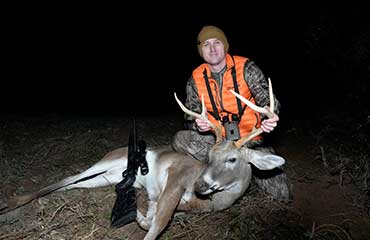One of the legacies left by longtime outdoor writer Jeff Murray is that he's credited with being among the first to connect deer movements to moon phases. It's a topic that has always been somewhat controversial, and yet continues to spark the interest of today's deer hunters looking for an edge. Is there an actual moon/deer connection? Some relatively recent research says there is.
During his career, Murray published two books on the subject. He also produced a yearly Moon Guide (a form of which continues to be available today) that pinpointed the best days and times to be out hunting. All of that is fascinating, but what might be even more notable are the results of a study aimed at uncovering some concrete moon/deer facts. What did it find? Well, it seems Mr. Murray was on the right track.
A report by Auburn University researchers presented at the Southeast Deer Study Group meeting in February considered the activity patterns of 22 GPS-collared male deer at a high-fence property in Alabama. During December through February of 2009 through 2011, researchers found that during the predicted movement periods of moonrise and moonset, bucks were 0.31 and 0.38 times as likely to be active on the highest-rated day versus the lowest-rated day as predicted by a solunar chart day-rating system. Which of course means the moon had little to no impact during these periods.
However, researchers also found that during the "moon underfoot" and "moon overhead" periods, bucks were 2.97 and 2.75 times as likely to be active on the highest rated day versus the lowest rated day, respectively. Researchers also found during moonrise and moonset a decreasing probability of movement as day rating increased, while for moon overhead and underfoot they noted an increasing probability of movement as day rating increased.
"What's interesting here are the findings of when the moon was overhead and underfoot, during the periods of early morning and late evening, which are prime hunting hours," said Brian Murphy, a veteran deer biologist present at the February meeting. "That's when [those two moon periods] are maximized for hunting purposes. That is the magic mix."
Murphy said that while the moon underfoot and overhead findings represent about a 10% increase in deer movement during these periods, he also said it's easy for hunters who follow strict hunting regimens dictated by one particular variable to let that skew their results.
"I would caution that if you are adjusting your hunting times and dates because of a particular variable, you're creating a self-fulfilling prophecy," Murphy said. "Then if you're successful you believe your variable made the difference. You don't know if you could have been successful a few days or weeks earlier because you weren't out there."
Murphy, an avid hunter and land manager, said he continues to consider hunting when he can to be his most-critical hunt factor, but realizes the advantage to anyone who hangs their hat — and hunt focus — on promising variables.
"When you believe you're going to be successful, you're more attentive, and it's likely you'll stay out there longer and generally hunt harder, and that alone can lead to more hunting success."
During his career, Murray published two books on the subject. He also produced a yearly Moon Guide (a form of which continues to be available today) that pinpointed the best days and times to be out hunting. All of that is fascinating, but what might be even more notable are the results of a study aimed at uncovering some concrete moon/deer facts. What did it find? Well, it seems Mr. Murray was on the right track.
A report by Auburn University researchers presented at the Southeast Deer Study Group meeting in February considered the activity patterns of 22 GPS-collared male deer at a high-fence property in Alabama. During December through February of 2009 through 2011, researchers found that during the predicted movement periods of moonrise and moonset, bucks were 0.31 and 0.38 times as likely to be active on the highest-rated day versus the lowest-rated day as predicted by a solunar chart day-rating system. Which of course means the moon had little to no impact during these periods.
However, researchers also found that during the "moon underfoot" and "moon overhead" periods, bucks were 2.97 and 2.75 times as likely to be active on the highest rated day versus the lowest rated day, respectively. Researchers also found during moonrise and moonset a decreasing probability of movement as day rating increased, while for moon overhead and underfoot they noted an increasing probability of movement as day rating increased.
"What's interesting here are the findings of when the moon was overhead and underfoot, during the periods of early morning and late evening, which are prime hunting hours," said Brian Murphy, a veteran deer biologist present at the February meeting. "That's when [those two moon periods] are maximized for hunting purposes. That is the magic mix."
Murphy said that while the moon underfoot and overhead findings represent about a 10% increase in deer movement during these periods, he also said it's easy for hunters who follow strict hunting regimens dictated by one particular variable to let that skew their results.
"I would caution that if you are adjusting your hunting times and dates because of a particular variable, you're creating a self-fulfilling prophecy," Murphy said. "Then if you're successful you believe your variable made the difference. You don't know if you could have been successful a few days or weeks earlier because you weren't out there."
Murphy, an avid hunter and land manager, said he continues to consider hunting when he can to be his most-critical hunt factor, but realizes the advantage to anyone who hangs their hat — and hunt focus — on promising variables.
"When you believe you're going to be successful, you're more attentive, and it's likely you'll stay out there longer and generally hunt harder, and that alone can lead to more hunting success."




.png)